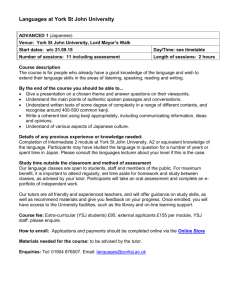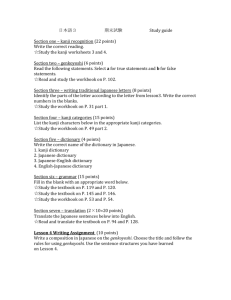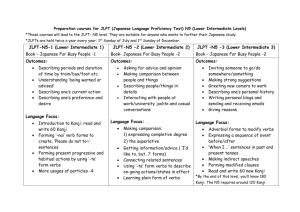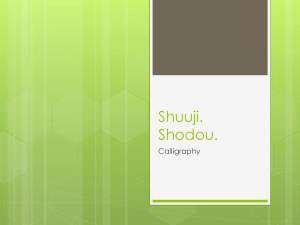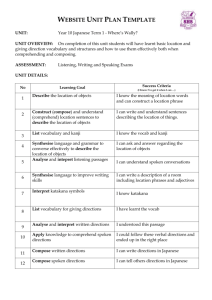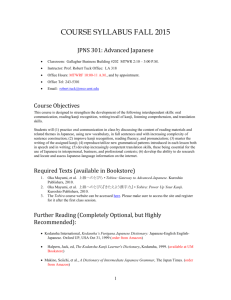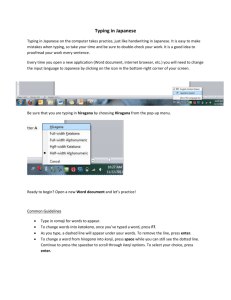Introduction to Kanji
advertisement
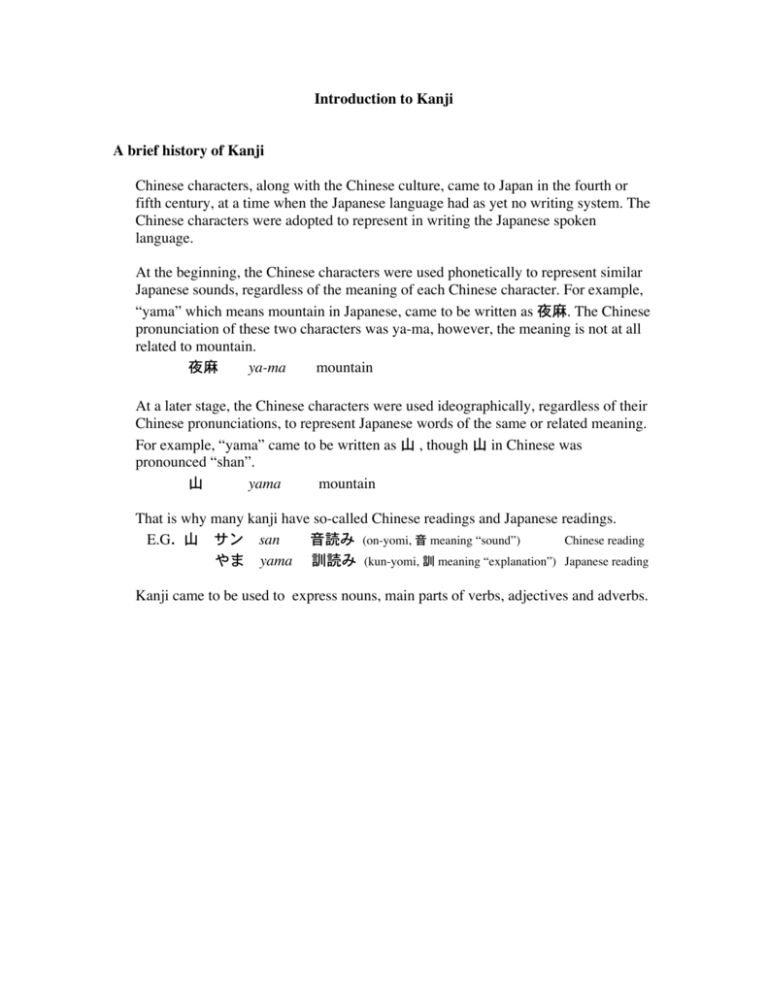
Introduction to Kanji A brief history of Kanji Chinese characters, along with the Chinese culture, came to Japan in the fourth or fifth century, at a time when the Japanese language had as yet no writing system. The Chinese characters were adopted to represent in writing the Japanese spoken language. At the beginning, the Chinese characters were used phonetically to represent similar Japanese sounds, regardless of the meaning of each Chinese character. For example, “yama” which means mountain in Japanese, came to be written as . The Chinese pronunciation of these two characters was ya-ma, however, the meaning is not at all related to mountain. ya-ma mountain At a later stage, the Chinese characters were used ideographically, regardless of their Chinese pronunciations, to represent Japanese words of the same or related meaning. For example, “yama” came to be written as , though in Chinese was pronounced “shan”. yama mountain That is why many kanji have so-called Chinese readings and Japanese readings. E.Gsan (on-yomi, meaning “sound”) Chinese reading yama (kun-yomi, meaning “explanation”) Japanese reading Kanji came to be used to express nouns, main parts of verbs, adjectives and adverbs. Why do Japanese kanji have more than one pronunciation? As explained above, many kanji have Chinese & Japanese readings. The pronunciations of Chinese characters were different depending on the periods and regions in China from which they were adopted. Over time, the Japanese people adopted three pronunciations as Chinese readings for the Japanese kanji. They are called (go sound) (kan sound) and (tou sound). (go sound) is the pronunciation used in the (Wu) region around the lower Yangtze River during the Southern & Northern Dynasties. These pronunciations were brought to Japan by the 6th century. (kan sound) is the pronunciation used in the northwest region during the T’ang Dynasty. They were brought to Japan by the Japanese delegations sent to the T’ang court during the 7th ~ 9th century. (tou sound, it is sometimes called sou sound) is the standard pronunciation during the Song Dynasty. They were brought to Japan by monks and merchants around 12th and 13th century. Here, for example, are three Chinese readings for the character . E.G. () One further reason for the proliferation of Chinese readings is that the Japanese people applied some Chinese characters to the Japanese original words when the meanings of those Chinese characters were the same as the Japanese words. Here, for example, are Japanese readings for the character . E.G. () to go () to do, carry out, perform Six ways of classifying Kanji Formation 1.Pictograph 象形文字 (しょうけいもじ) Kanji created from simple illustrations of objects in daily life → → → → 山 mountain → → → → 日 sun → → → → 手 hand 2.Ideograph 指事文字 (しじもじ) Kanji created to indicate abstract concepts → 上 on, up → 下 under, below → 三 three 3. Phono-semantic characters 形声文字 (けいせいもじ) Kanji created by combining an element expressing the meaning and an element expressing the sound <meaning> <sound> 心 heart + ఫ hi → 悲 <pronunciation> hi <meaning> sorrow, sad 金 gold, metal + 同 → ସ <pronunciation> dou <meaning> copper dou 4. Compound ideographs 会意文字 (かいいもじ) Kanji created by combining two or more kanji The compound kanji is related to the meaning of the original kanji but the sound has nothing to do with the original ones. <meaning> <meaning> 日 sun + 月 moon → 明 <meaning> bright 人 person + 木 tree → 休 <meaning> to rest Usage 1. Associated meaning characters 転注 (てんちゅう) Kanji used to express words related to or associated with a kanji’s core meaning 好 楽 beauty, virtue, goodness music → 好む(このむ)<meaning> to like → 楽しむ(たのしむ) <meaning> to enjoy 2.Provisional-use characters 仮借 (かしゃ) Kanji used for phonetic purpose only, with no regard for their meaning 亜米利加(アメリカ) <meaning> America (America is usually written in Katakana) 10Basic Strokes 画(かく 、 stroke) All kanji can be written with some combination of 10 basic strokes. 1. よこせん (a horizontal line) 2. たてせん (a vertical line) 3. ななめせん (a diagonal line) 4. てん (a dot) 5. ななめかぎ (a stroke which includes a diagonal line and hook or change of direction) 6. てかぎ (a curved stroke with a hook formed like the last stroke in the kanji 手, pronounced て、meaning “hand”) 7. かくかぎ (a stroke with a corner) 8. あひる (The name of this stroke means “duck,” but it is unclear why this is so.) 9. くのじ (the hiragana character く 10. つりばり (a fish hook) ) Basic Rules of Stroke Order 書き順 (かきじゅん) A kanji must be written according to a fixed stroke order so that it will look neat and well-balanced. Here are the basic rules of stroke order. Note that these are the basic rules of stroke order. There are exceptions to these rules. At the beginning of the study of kanji it may see burdensome to have to learn the meaning of each character, two or more pronunciations, and correct stroke order as well. However, stroke order is quite systematic, so if you make an effort to learn it correctly in the beginning, you will find that you will know how to write the stroke order of most of characters you later encounter. Note, that neat handwriting is valued in Japan. People who write sloppily may be considered to be uneducated or stupid. Click on each Kanji to view a (stroke by stroke) movie. *Hit 'esc' key to close the movie. 1. From top to bottom 三 ਥ 2. From left to right 行 例 3. When two or more strokes cross, horizontal strokes usually precede vertical ones 十 本 4. Center first, then left and right 小 楽 5. A vertical line running through the center is written last 中 車 6. A horizontal stroke that goes through the entire kanji is written last 子 母 7. Outer frame first, but bottom line last 口 国 8. Right-to left diagonal stroke precedes left-to-right 人 9. Nyo, ,, are written last 道 10. Nyo, , ࡧ 文 (two of the radicals which wrap around the lower left of a kanji) 延 (these two nyo, or wrapping kanji) are written first 魅 11. First the vertical stroke then the short horizontal stroke which adjoins it on the right 上 12. A dot at the north-east corner is written last 犬 代 3 ways to end a stroke 1. stop 止め The writer does not begin to lift upon the brush or pen until the stroke is completed. 2. sweep はらう The writer begins to let up on the brush or pen before finishing writing the character. Thus the end of the stroke becomes thin and stretched out. 3. hook はねる At the end of the stroke the writer lifts the brush or pen abruptly at a diagonal. The small “hook” should not be made too large. Radicals ಊ首 Kanji are classified in a kanji dictionary according to their main components which are called radical (roots) in English and ಊ首(ぶしゅ)in Japanese. ಊ(ぶ)means a group and 首(しゅ) means a chief. There are 214 historical radicals. You will soon become familiar with the most frequently used radicals. Almost no one uses all 214 radicals. Here are 8 representative categories of radicals according to their position within a character and some examples. 1. へん radicals on the left side of the kanji person にんべん strength ちからへん soil つちへん mouth くちへん woman おんなへん child こへん mountain やまへん cloth はばへん bow ゆみへん street, to go ぎょうにんべん hand てへん mind, spirit, heart りっしんべん sun, time にちへん moon, period つきへん tree, wood きへん water, sea, river さんずいへん beast けものへん jewery たまへん field たへん eye, to see めへん stone いしへん altar, festival, religious service しめすへん grain のぎへん thread いとへん meat, flesh にくづき insect, bug, reptile むしへん clothing ころもへん word, to speak, say ごんべん shell, property, wealth かいへん car くるまへん sake jar, bird とりへん、ひよみのとり metal, mineral, gold かねへん food, to eat しょくへん horse うまへん fish うおへん bird とりへん hill, mound こざと 2. つくり radicals on the right sword りっとう village, country おおざと head, face おおがい small bird ふるとり 3. かんむり radicals on the top house, dwelling place うかんむり bamboo たけかんむり grass, plant くさかんむり rain, cloud あめかんむり 4. あし radicals on the bottom fire, to burn れっか、れんが human legs ひとあし plate さら contrary, to err まいあし 5. かまえ radicals which enclose the kanji territorial boundaries くにがまえ gate もんがまえ box はこがまえ steam きがまえ 6. たれ radicals which hand down roof まだれ sickness やまいだれ door とだれ awning しかばね 7. にょう radicals which wrap around the bottom of a character road, walk, to advance しんにょう stretching えんにょう to run そうにょう demon きにょう 8. one stroke radicals dot てん the second おつ(にょう) vertical stroke with a hook はねぼう vertical stroke たてぼう diagonal sweeping stroke のかんむり、はらいぼう one, horizontal stroke いち This document is prepared by Harumi Hibino Lory, proof-read by Janet Fair, with technical support from Keiko Yoshimura.
